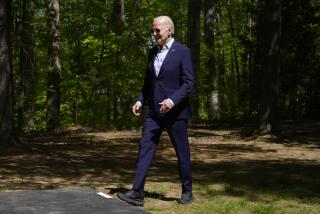BP report on well disaster faults mechanical, human failures
An internal investigation released Wednesday by BP concluded that a series of mechanical and human failures by its own crews and its contractors led to the explosion on the Deepwater Horizon drilling rig, which killed 11 men and set in motion one of the world’s worst oil spills.
The oil company accepted a share of the responsibility but also took aim at contractors Transocean and Halliburton, setting off another round of finger-pointing that began soon after the rig sank.
No single factor caused the disaster, concludes the 234-page report summarizing the first of several investigations of the disaster. “A complex and interlinked series of mechanical failures, human judgments, engineering design, operational implementation and team interfaces came together to allow the initiation and escalation of the accident.”
BP’s investigative team cited eight problems, including an incorrectly read pressure test, a blowout preventer that didn’t function properly, a faulty cement seal job and the failure of the rig crew to recognize that gas was surging up the well just before the explosion.
“We have said from the beginning that the explosion on the Deepwater Horizon was a shared responsibility among many entities,” BP’s incoming Chief Executive Robert Dudley said in a statement.
“We deeply regret this event,” he added. “We are determined to learn the lessons for the future and we will be undertaking a broad-scale review to further improve the safety of our operations. We will invest whatever it takes to achieve that.”
Transocean, the drilling rig owner, assailed the BP report as “self-serving,” contending that BP’s “fatally flawed well design” set the stage for the rig explosion 50 miles off the Louisiana coast.
Halliburton, which did the well cementing, said it found a “number of substantial omissions and inaccuracies” in the report and “remains confident that all the work it performed … was completed in accordance with BP’s specifications.”
Based on a four-month investigation led by company safety chief Mark Bly, the BP document wraps up the first of a series of reviews looking into the gulf catastrophe. The U.S. Coast Guard, the federal Bureau of Ocean Energy Management, Regulation and Enforcement and President Obama’s National Commission are all investigating the accident. The Justice Department is also trying to determine whether BP skirted federal safety regulations.
Pieces of equipment key to the inquiries, including the failed blowout preventer, were recently retrieved from the seafloor and have yet to be thoroughly examined.
More than 200 million gallons of oil were released after the April 20 explosion, which occurred when workers lost control of the well and gas rushed into the rig and erupted in flames. In addition to the dead, 17 others were injured.
Although the 18,360-foot-deep well has not leaked since it was capped in mid-July, BP and the federal government are still working on a permanent seal at the well’s bottom. Officials now say that remedy may not be completed until early October.
Testimony at hearings conducted this summer by the Coast Guard and the Department of the Interior sketched a picture of deferred maintenance on the Deepwater Horizon rig, a confused chain of command and corporate pressure to finish the deep-sea drilling job, which was six weeks behind schedule and costing BP more than $1 million a day.
Federal investigators have questioned BP’s decision to replace its longstanding well site leader with a new man four days before the fatal explosion, as well as the replacement’s competency at reading critical pressure tests, which determined whether the well was properly sealed. An erroneous interpretation of a pressure test was among the eight “critical factors” identified in the BP report.
BP’s well design has come under scrutiny, particularly the use of six centralizers versus the 21 recommended by Halliburton. Experts say that using more centralizers — which keep the casing centered in the well bore — help produce a more consistent cement seal.
Hearing testimony also revealed that BP employed a well configuration that called for a single string of pipe rather than a more expensive design that would have created more barriers to prevent the flow of gas into the well casing and to the rig.
Transocean, responding to the BP report Wednesday, maintained that in its design and construction of the well, BP “made a series of cost-saving decisions that increased risk — in some cases, severely.”
BP’s outgoing chief executive, Tony Hayward, defended the well design Wednesday and pointed a finger at Halliburton’s work. “To put it simply, there was a bad cement job,” he said in a statement. “Based on the report, it would appear unlikely that the well design contributed to the incident.”
The BP investigation found human fault, concluding that rig workers should have known from computer data that gas was flowing into the well for at least 40 minutes before the explosion. But crew members testified at the federal hearings that some gas alarm systems had been either bypassed or disarmed on the orders of rig officials.
On Capitol Hill, lawmakers faulted BP for not shouldering more of the blame. “This report is not BP’s mea culpa,” said Rep. Edward J. Markey (D-Mass.), a senior member of the House Energy and Commerce Committee. “BP is happy to slice up blame, as long as they get the smallest piece.”
Energy chair Rep. Henry A. Waxman (D-Beverly Hills), complained that the BP document failed to “address the corporate culture at BP that shortchanged safety and caused so much harm to the gulf and the Deepwater Horizon workers.”
Still, Elgie Holstein, oil spill response coordinator for the nonprofit Environmental Defense Fund and a former Energy Department chief of staff, said the report “has some value.”
In identifying the various failures of “man and machine,” Holstein said, BP has provided “something of a blueprint that can be used to design new operating protocols, training programs, and equipment needs. In addition, I think it underscores the need to implement more robust, redundant safety systems that can ensure that we never have another accident of this magnitude.”
richard.simon@latimes.com
bettina.boxall@latimes.com
Simon reported from Washington and Boxall from Los Angeles. Times staff writers Julie Cart and Rong-Gong Lin II in Los Angeles and Richard Fausset in Atlanta contributed to this report.
More to Read
Start your day right
Sign up for Essential California for news, features and recommendations from the L.A. Times and beyond in your inbox six days a week.
You may occasionally receive promotional content from the Los Angeles Times.







